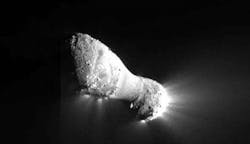NASA considering coin-sized microbolometer camera to study comets, asteroids
Two NASA teams want to deploy a highly compact, sensitive thermometer that could characterize comets and even assist in the redirection or possible destruction of an asteroid on a collision course with Earth. In two technology-development efforts, researchers at NASA's Goddard Space Flight Center (Greenbelt, MD) are baselining the use of a Goddard-designed infrared microbolometer camera--whose cross section is just slightly larger than a quarter--to study near primitive objects formed during the solar system's origin 4.5 billion years ago.
The multispectral instrument, called the Comet CAMera, or ComCAM, was designed in part by Goddard scientist Shahid Aslam. He worked closely with the device’s manufacturer, the Canadian-based National Optics Institute, to design the compact optics and integrated filters that make the device sensitive to chemical compounds, like water and carbon dioxide, which are of interest to cometary scientists.
RELATED ARTICLE: Microbolometer arrays enable uncooled infrared camera
Thermal sensors, like ComCAM, measure infrared or heat radiation, and are, in essence, very sensitive thermometers. When radiation strikes an absorptive element, the element heats and experiences a change in the electrical resistance, which is proportional to and can be used to derive the temperature. These measurements provide insights into the physical properties of the object being studied. Scientists often use them to study very distant stars and galaxies in the universe. Microbolometers used to study galaxies and the interstellar medium in the far-infrared and submillimeter wavelength bands require super cooling, which typically is done by placing the sensor inside a cryogenically cooled canister.
In sharp contrast, infrared microbolometers like the one developed in part by Aslam operate with minimal cooling and do not require placement inside a canister. As a result, these cameras are lighter in weight and smaller, yet still capable of sensing and recording infrared heat emanating from objects in the solar system.
Because of these attributes, scientist Tilak Hewagama, who is affiliated with the University of Maryland-College Park, and his team--which includes Aslam, Catholic University's Nicolas Gorius, and others from Goddard, the University of Maryland, Morehead State University, the Jet Propulsion Laboratory, and York University--now want to fly ComCAM and a traditional visible-light camera on a potential CubeSat mission called the Primitive Object Volatile Explorer, or PrOVE.
"A CubeSat deployed from a parked orbit can produce high-quality science by traveling to any comet that passes through the accessible range, rather than a dedicated mission that cannot be prepared in time to investigate a new, pristine comet that comes into view," Hewagama said. With the PSDS3 support, the team is identifying long-term parking orbits or "waypoints," transfer trajectories to these waypoints, spacecraft longevity, intercept trajectories, and propulsion requirements to reach specific known comets and practical ranges for missions to new comets, among other topics.
Given the fact that PrOVE is comprised of existing commercial-off-the-shelf components, including a 6- or 12-unit CubeSat bus and the microbolometer camera, Hewagama believes the mission could be completed and launched as a secondary payload in relatively short order.
Comet science isn't the only potential beneficiary of a PrOVE-like microbolometer camera. Under another research effort, Goddard technologists Josh Lyhoft and Melak Zebenay are evaluating different sensor systems needed to image and characterize an asteroid on a collision course with Earth. These sensors could provide a spacecraft with the guidance measurements needed to either deflect or destroy the object.
Since Lyhoft began his investigation, NASA announced that teams developing the agency's first asteroid-deflection mission--the Double Asteroid Redirection Test, or DART--would begin preliminary designs. Under this mission, led by scientists from the Johns Hopkins Applied Physics Laboratory, with support from Goddard and other organizations, DART would employ a kinetic impactor to conduct a test that would help demonstrate capabilities that may one day be needed to nudge an asteroid away from its path to Earth. A test with a small, non-threatening asteroid (the smaller of two asteroids making up the Didymos system) is planned for 2024.
SOURCE: NASA; https://www.nasa.gov/feature/goddard/2017/nasa-evaluates-use-of-a-coin-sized-thermometer-to-characterize-comets-and-earthbound

Gail Overton | Senior Editor (2004-2020)
Gail has more than 30 years of engineering, marketing, product management, and editorial experience in the photonics and optical communications industry. Before joining the staff at Laser Focus World in 2004, she held many product management and product marketing roles in the fiber-optics industry, most notably at Hughes (El Segundo, CA), GTE Labs (Waltham, MA), Corning (Corning, NY), Photon Kinetics (Beaverton, OR), and Newport Corporation (Irvine, CA). During her marketing career, Gail published articles in WDM Solutions and Sensors magazine and traveled internationally to conduct product and sales training. Gail received her BS degree in physics, with an emphasis in optics, from San Diego State University in San Diego, CA in May 1986.
